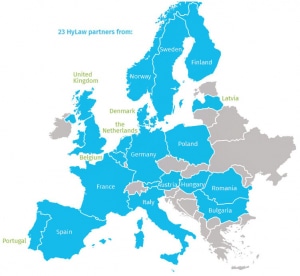The aim of the EU-funded HyLaw project is to promote the launch of hydrogen and fuel cell technologies by giving stakeholders a detailed overview of current regulations and showing political decision makers where the sector is faced with legal barriers to growth. Coordinated by Hydrogen Europe, it is the EU’s first project that focuses on regulatory issues concerning hydrogen production and sale.
In all, 23 partner organizations are working on the HyLaw project, funded by the Fuel Cells and Hydrogen Joint Undertaking (see fig. 1), with the representatives for Germany coming from hydrogen and fuel cell association DWV. In early 2017, the participating researchers began identifying rules and regulations relevant to hydrogen and fuel cells and the legal barriers to market these technologies. This first project stage focused on hydrogen production, storage, transport and supply, as well as fueling stations, vehicles, pipeline injection, electrolyzers and stationary fuel cells. Other topics, including hydrogen trains, river watercraft, the national pipeline system and underground storage will be addressed at a later stage.
In contrast to other EU member countries, Germany has already had an apt and detailed regulatory framework in place, including numerous laws, regulations, standards and worksheets on relevant rules. Usually, they serve their purpose and are clear enough to be understood. Nevertheless, the wording of some of them is imprecise, or leaves room for misinterpretation, which leads to risky investments or much effort and too many resources being spent on regulatory procedures. The following paragraphs will be used to provide some examples.
Hydrogen as fuel
Since January 2018, organizations have been able to offset hydrogen or synthetic natural gas, or SNG for short, against GHG amounts released into the atmosphere. The rules for crediting those amounts are found in Sec. 3 (2) of the 37th BImSchV federal pollution regulation. However, their narrow and impractical definition does not provide an impetus for the hydrogen market. As a consequence, the ambitious aims for transportation, set out in the new EU-wide Renewable Energy Directive II, would, in all likelihood, not be met.
…
Read more in H2-international April 2019


























0 Comments